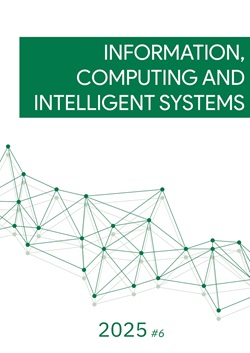Hexacopter-Based Cyber-Physical System for Water Sampling with Adaptive Path Planning and Multi-Drone Coordination
DOI:
https://doi.org/10.20535/2786-8729.6.2025.333426Keywords:
Water Sampling, Cyber-Physical Systems, Environmental Monitoring, Multi-Drone Coordination, Autonomous UAV, Mission PlanningAbstract
The object of this study is a hexacopter-based cyber-physical system designed for autonomous water sampling to support environmental monitoring, addressing the problem of inefficient control under dynamic conditions. The subject focuses on integrating physical flight control and water sampling operations with cyber supervisory functions, including real-time waypoint navigation, task scheduling, and multi-drone coordination, validated as a current system component. The research investigates the system’s performance under payload variations and wind disturbances, ensuring robustness and precision in adverse environments. The purpose is to improve efficiency of water sampling through this CPS, achieving enhanced flight stability and positioning accuracy via a cascade PID control system, optimizing mission planning with adaptive cyber strategies, and increasing scalability through multi-drone operations. This approach aims to surpass traditional UAV systems by using physical-cyber integration for precise, robust, and scalable water quality assessment.
The methodology combines simulation-based and analytical techniques to develop and assess the hexacopter CPS. A 6-degree-of-freedom mathematical model, based on Newton-Euler equations, was constructed in MATLAB/Simulink to simulate hexacopter dynamics, incorporating payload and wind effects. The cascade PID control system was tuned using the Ziegler-Nichols method, with iterative optimization to reduce overshoot and settling time across three scenarios: 1 kg static payload, 1.5 kg dynamic payload, and 5 m/s wind. The cyber supervisory system, implemented in ROS 2, employs graph-based algorithms (Dijkstra’s for waypoint navigation, list-scheduling for task allocation) and a consensus protocol for multi-drone coordination, tested in a 500x500 m² environment. Performance metrics, such as position root mean square error (RMSE) and attitude errors, were analyzed to evaluate system effectiveness.
Results demonstrate significant improvements in water sampling capabilities. The cascade control system achieved a 40–50% reduction in position RMSE and maintained attitude errors
within ±0.8° to ±1.2°, ensuring stable flight. The cyber-physical framework reduced mission time
by 15% through adaptive path optimization, while multi-drone coordination increased sampling coverage by 20%, enhancing scalability. These outcomes reflect the system’s precision and robustness that highlight novel control and coordination strategies with practical value for environmental monitoring. The study provides a foundation for future ecological applications.
References
JP. Ore, S. Elbaum, A. Burgin, B. Zhao, C. Detweiler, “Autonomous Aerial Water Sampling”. In: L. Mejias, P. Corke, J. Roberts “Field and Service Robotics”, Springer Tracts in Advanced Robotics, vol 105. Springer, Cham, https://doi.org/10.1007/978-3-319-07488-7_10.
C. Koparan, “UAV-assisted water quality monitoring”, Dissertation, Clemson University, 2020.
I. M. G. Lariosa, J. C. Pao, C. A. G. Banglos, I. P. Paradela, E. R. M. Aleluya, C. J. O. Salaan, C. N. Premachandra, “Drone-Based Automatic Water Sampling System”, in IEEE Access, vol. 12, pp. 35109–35124, 2024, https://doi.org/10.1109/ACCESS.2024.3372655.
INTCATCH, “Development and application of innovative methods for monitoring water quality”, Horizon 2020 Project Report, 2020. [Online]. Available: http://www.intcatch.eu.
R. Mahony, V. Kumar and P. Corke, “Multirotor Aerial Vehicles: Modeling, Estimation, and Control of Quadrotor”, IEEE Robotics & Automation Magazine, vol. 19, no. 3, pp. 20–32, Sept. 2012, https://doi.org/10.1109/MRA.2012.2206474.
P. Pounds, R. Mahony, and P. Corke, “Modelling and control of a large quadrotor robot”, Control Eng. Pract., vol. 18, no. 7, pp. 691–699, Jul. 2010, https://doi.org/10.1016/j.conengprac.2010.02.008.
K. Alexis, G. Nikolakopoulos, and A. Tzes, “Model predictive quadrotor control: Attitude, altitude, and position experimental studies”, IET Control Theory Appl., vol. 6, no. 12, pp. 1812–1827, Aug. 2012, https://doi.org/10.1049/iet-cta.2011.0348.
K. Rajan and A. Saffiotti, “Towards a science of integrated AI and robotics”, Artif. Intell., vol. 247, pp. 1–9, Jun. 2017, https://doi.org/10.1016/j.artint.2017.03.003.
Y. Liu, Z. Liu, J. Shi, G. Wu, and W. Chen, “Optimization of base location and patrol routes for unmanned aerial vehicles in border intelligence, surveillance, and reconnaissance”, J. Adv. Transp., vol. 2019, pp. 1–13, Jun. 2019, https://doi.org/10.1155/2019/9063232.
E. Dhulkefl, A. Durdu, and H. Terzioğlu, “Dijkstra algorithm using UAV path planning”, Konjes, vol. 8, pp. 92–105, 2020, https://doi.org/10.36306/konjes.822225.
L. Zhu, J. Du, Y. Wang, and Z. Wu, “An online priority configuration algorithm for the UAV swarm in complex context”, Procedia Comput. Sci., vol. 150, pp. 567–578, 2019, https://doi.org/10.1016/j.procs.2019.02.095.
H. T. Do, H. T. Hua, M. T. Nguyen, C. V. Nguyen, H. T. T. Nguyen, H. T. Nguyen, and N. T. T. Nguyen, “Formation control algorithms for multiple-UAVs: A comprehensive survey”, EAI Endorsed Trans. Ind. Netw. Intell. Syst., vol. 8, no. 27, art. no. e3, Jun. 2021, https://doi.org/10.4108/eai.10-6-2021.170230.
A. Pysarenko and O. Rolik, “Energy-efficient autonomous unmanned water sampling system for environmental monitoring”, Adapt. Syst. Autom. Control, vol. 1(46), pp. 267–282, 2025, https://doi.org/10.20535/1560-8956.46.2025.323886.
M. Polishchuk and O. Rolik, “Improvement of technological equipment drone for water sampling: Design and modeling”, FME Transactions, vol. 52, no. 2, pp. 237–245, 2024, https://doi.org/10.5937/fme2402237P.
Downloads
Published
How to Cite
Issue
Section
License
Copyright (c) 2025 Information, Computing and Intelligent systems

This work is licensed under a Creative Commons Attribution 4.0 International License.




